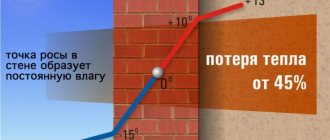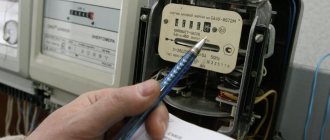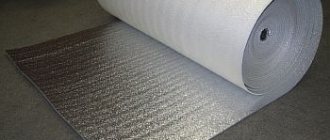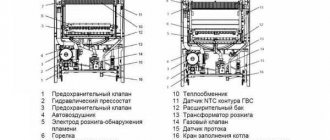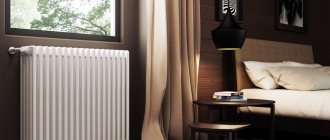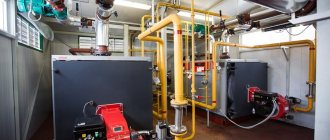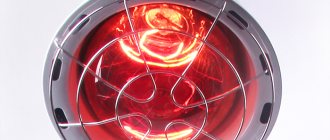To select the cross-section of power cables and wires when laying electrical networks for consumers, you need to know what power devices will be included in them. You can learn how to calculate the power consumption of an electrical appliance by understanding the very concept of power. For this, information from the school curriculum and basic concepts about current, voltage, and resistance will be enough. In addition, this knowledge is needed when purchasing household electrical appliances.
Electric current power
Total power and its components
Electrical power is a quantity responsible for the rate of change or transmission of electricity. The total power is denoted by the letter S and is found as the product of the effective values of current and voltage. Its unit of measurement is volt-ampere (VA; V A).
Total power can consist of two components: active (P) and reactive (Q).
Active power is measured in watts (W; W), reactive power is measured in vars (Var).
It depends on what type of load is included in the electricity consumption circuit.
Active load
This type of load is an element that resists electric current. As a result, the current does the work of heating the load, and the electricity is converted into heat. If a resistor of any resistance is connected in series to a battery, then the current passing through the closed circuit will heat it until the battery is discharged.
Attention! An example of a thermal electric heater (TEH) can be given as an active load in AC networks. The heat generated on it is the result of the work of electricity.
Similar consumers also include spirals of light bulbs, electric stoves, ovens, irons, and boilers.
Capacitive load
Such loads are devices that can accumulate energy in electric fields and create movement (oscillation) of power from source to load and back. Capacitors, cable lines (capacitance between conductors), capacitors and inductors connected in series and parallel in a circuit serve as capacitive loads. Sound power amplifiers and synchronous electric motors in overexcited mode also load the lines with a capacitive component.
Inductive load
When the consumer of electricity is certain equipment, which includes:
- transformers;
- three-phase asynchronous motors, pumps.
On the plates attached to the equipment you can see such a characteristic as cos ϕ. This is the phase shift coefficient between current and voltage in the alternating current network into which the equipment will be connected. It is also called the power factor; the closer cos ϕ to unity, the better.
Important! When a device contains inductive or capacitive components: transformers, chokes, windings, capacitors, the sinusoidal current lags in phase with the voltage by a certain angle. Ideally, the capacitance provides a phase shift of -900, and the inductance provides a phase shift of +900.
Cos ϕ values depending on the type of load
The capacitive and inductive components together form reactive power. Then the total power formula looks like:
S = √ (P2 + Q2),
Where:
- S – apparent power (VA);
- P – active part (W);
- Q – reactive part (Var).
If we display this graphically, then we can see that the vector addition of P and Q will be the total value of S - the hypotenuse of the power triangle.
Graphic explanation of the meaning of total power
Energy Saving Tips
Having analyzed energy costs, many owners involuntarily wonder if it is possible to somehow reduce them? Typically, large consumption is affected by refrigerators and lamps.
To reduce the consumption of a refrigerator, it must be moved away from the wall so that it is better ventilated, or replaced with a new one with better consumption readings.
It is optimal to use energy-saving light bulbs. They come in two types: LED and mercury. The latter are cheaper, but less durable, have lower efficiency and require special disposal rules. LED lamps are the best option. Provided they are made with high quality, they last a long time, can be produced in different colors, adjustable power, and as a rule, the manufacturer gives them a long warranty.
Negative effects of reactive load
Learn to easily calculate the power consumption of an electrical appliance
The reactive load does not perform any useful work. Fluctuations in the reactive component from source to consumer only cause parasitic losses. In addition, industrial enterprises are required to pay for the reactive energy supplied to them. This is due to the fact that most energy receivers are electric motors and transformers. The amount of electricity consumed (kWh) does not all go to useful work, but you also need to pay for its reactive component.
Capacitor compensation units will help solve this problem. After all, if you connect a capacitive load in parallel with an inductive load, you can reduce the effect of parasitic currents to a minimum. Such installations are installed at substations supplying consumers.
Safety
Any electrical appliance is a source of danger, careless handling of which can lead to electrical injuries. In addition, equipment may break, exposing the user to the risk of electric shock.
Most stationary kitchen appliances must be connected to a three-wire electrical network, with one conductor connected to the ground loop. But what if the house is not equipped with it? But these are the majority in our country. The simplest solution is to install a residual current device (RCD), which will instantly disconnect the line when a leakage current is detected on it, thereby minimizing the risk of electric shock. To save space in the distribution panel, instead of a circuit breaker and RCD, you can use a differential circuit breaker. True, this solution is somewhat more expensive.
Source
Formula for calculations
How to calculate electrical energy consumption
All data necessary to be substituted into the formula for calculations can either be measured or taken from the characteristics of the instruments used.
For your information. If the passport data indicates the value of cos ϕ, it means that the electricity received by the device will have a reactive component. This also needs to be taken into account when calculating.
The formula for calculation is:
P = I * U * cos ϕ,
Where:
- I – current in amperes;
- U – voltage in volts;
- cos ϕ – phase shift.
In the case of an active load, the phase shift is not substituted into the formula, and it has the form:
P = I * U.
Explanation of energy efficiency labels
The higher the energy consumption class of the device, the more efficiently it will work, while economically consuming energy resources. Products with the letter A marked on the packaging have the lowest energy consumption; products of class G, on the contrary, are the least efficient to use.
The gradation of consumer properties of a product by energy consumption class consists of ten steps. The energy consumption class affects prices: as the class increases, the cost of the product also increases.
At the same time, if your household appliances do not reach the first letter of the alphabet, this does not mean that they are bad. Products of classes “B” and “C” are also considered economical, since they spend only 75% and 95% of the norm, which in any case is less than 100%.
The quality and energy efficiency of devices may be higher than A. Some models may be marked “A+”, “A++” or “A+++”, which means they are even more efficient in use. Energy saving classes such as E, F, G, due to wastefulness of electricity, are practically not found among the characteristics of modern products.
“A+” class equipment will spend up to 42% of electricity from the standard 100%, a product with o will spend up to 30% of electricity, and an “A+++” class model will spend up to 22%.
The color will also tell you about the energy consumption class: the highest energy efficiency class is indicated by the darkest green color, a burgundy shade will indicate very high energy consumption. The cooler the color, the better.
Features of calculation
To calculate power without having complete data on current and voltage consumption, you can use average characteristics. By consulting reference books, you can find out that lighting equipment can consume current up to 15 A. The maximum current of powerful devices reaches 50-60 A. The power factor, if it is not indicated or known, can be taken as 0.7 - this is the average value.
Single-phase voltage in a household network is 220 V. Its linear value in three-phase networks is 380 V.
Computer
The main source of consumption is the system unit. It has a power supply installed, and once you know its power characteristics, you can estimate the approximate consumption. As a rule, this is 300-600 W. But this is the maximum power; it is unlikely that the computer will only consume even under full load.
Additionally, you need to take into account the monitor and other equipment, if it is turned on (printer, scanner, modem, speakers). In total, for an average computer, consumption is about 550 W (0.55 kW). But taking into account downtime and performing simple tasks, the average value is taken - 0.5 kW. It turns out that if you use a computer for 6 hours a day, then it consumes about 90 kWh per month. Accordingly, if the computer does not turn off around the clock, then its maximum monthly consumption will exceed 300 kWh.
Mathematical operations
The basic formula allows you to calculate an unknown quantity when the other two are known. For example, if the current consumed by the device is known I = 2 A and the network voltage U = 220 V, then the power consumption is equal to P = 2 * 220 = 440 W.
For example, it is known that the iron consumes 2 kW, and the voltage in the outlet is 220 V, then you can find the current strength for which the cross-section of the power cord is designed.
I = P/U = 2000/220 = 9.1 A.
In the case of fractional values, when using a calculator for calculations, the obtained values are rounded to tenths of the units of the desired value.
Basic formulas for calculation
A little history
Labeling the energy consumption class of a product has been used in Europe since the 90s of the 19th century. Now the label is used in more than 50 countries around the world. Mandatory energy efficiency labeling has become a key tool for efficient energy consumption and a driving force for reducing the energy intensity of the gross national product. In practice, there are now two energy efficiency labeling systems:
- The American Energy Guide model, which involves analyzing the energy consumption of similar products and selecting from them about 25% with the lowest energy consumption, which are assigned the Energy Guide brand
- The labeling model adopted in the EU countries, which involves dividing all products of the same type into seven classes, from A to G. The same designations apply in Russia. The division is made according to the ranges of quantitative indicators of energy efficiency throughout the entire range of characteristics from the most economical to the most energy-wasting
The main levers of influence of energy efficiency labeling on the energy intensity of the economy include:
- restrictions on the export of energy-intensive products (the import of products of classes F and G into the EU countries is prohibited, and temporary restrictions have been introduced on the middle classes D and F)
- linking energy efficiency with carbon dioxide emissions into the atmosphere, implying the inclusion of labeling in the system of sales of air emission quotas
- a system of fiscal measures to limit the production and sale of energy wasteful equipment
- state support for those enterprises that are focused on using energy-efficient goods in the production
- discounts for consumers choosing energy efficient technologies
- promotion of energy saving and respect for the environment
Rules for calculating power consumption
In everyday life, when the need arises to independently determine the power consumption of electricity, do the following:
- determine the voltage required to power the device;
- find out the rated current from the passport data.
How to find out the power of an electrical appliance if not a single parameter is known? Household electrical appliances are designed for 220 V.
To determine power, it is permissible to measure current consumption. This can be done using an ammeter. It is connected to the circuit in series, having previously set the highest measurement limit - at least a hundred amperes. Current clamp meters will help you easily measure current, for which one of the conductors is grasped by the clamp sensor, and the readings are displayed on the display. Knowing the voltage, multiply it by the measured current to obtain the amount of power consumed.
Clamp meter
Cost of electricity consumption
To estimate the amount you will have to pay for electricity, you need to know the average cost for your region of residence. Let’s say this figure is 4 rubles per kW*hour.
Next, you should multiply the resulting number (from the monthly meter) by the price. For example: consuming 100 kWh of electricity per month will cost 400 rubles.
There are many online calculators that can help you calculate this figure more accurately. The cost may depend on some other criteria: the presence of a multi-tariff meter, benefits, total monthly consumption, and so on.
Calculation of light bulb power
The selection of incandescent lamp power depends on the desired level of illumination of the living space. One 100 W light bulb, working in the dark for at least 12 hours, consumes 1.2 kW of power. For a month this will be 36 kW, for a year - at least 432 kW. If there are 10 light bulbs in an apartment, then the total annual consumption will be 4320 kW. If the price for 1 kW of electricity is 5 rubles, the amount turns out to be decent – 21,000 rubles. Therefore, replacing incandescent lamps with energy-saving light sources: LED lamps, LED strips and the like allows you to save money. In addition, reducing the power of such light bulbs does not reduce the luminous flux. The reduced supply voltage of LED strips also reduces the amount of power consumed.
What expenses does this add up to over a year - simple calculations for saving
To understand how much the devices “heat” their owner, you need to analyze the electricity consumption rates, and then calculate how much time per day the switched off units continue to “eat” money.
The total annual energy consumption of certain types of appliances and devices, expressed in money, is given in the last column of the table.
| No. | Consumer name | Average electricity consumption, W/hour | The amount that will have to be paid for downtime per year, Russian rubles |
| 1 | Electric coffee maker | 4-6 | 105,80-158,70 |
| 2 | Microwave oven (no grill) | 6 | 158,70 |
| 3 | LCD TV | 11-16 | 290,95-423,20 |
| 4 | LED TV | 1-2 | 26,45-52,9 |
| 5 | Personal computer (system unit) | 1-3 | 26,45-79,35 |
| 6 | LCD monitor | 1 | 26,45 |
| 7 | Laptop charger (without consumer) | 15 | 396,75 |
| 8 | Laptop charger left on the wire | 20-30 | 529,00-793,50 |
| 9 | Phone charger, smartphone | 2-3 | 52,90-79,35 |
Please note that the calculation in the last column is based on:
- the downtime of the “devourers” is equal to 8 hours;
- total number of days in a year (365);
- the cost of 1 kW/hour, equal to 4.53 Russian rubles (taken from a simple meter).
If you expand the list of home appliances, take into account the actual time they spend in standby mode, calculate the cost of a kilowatt at the correct tariff, and then add up all the “empty” costs, then the final amount may not be so harmless.
We hope that now you understand where the readings on the electricity meter come from, and you will also be able to save your money by disconnecting passive consumers from the network.
Power measurement devices
To measure P, you can use special instruments. A multimeter is suitable for this, to which you can connect a current clamp. How to measure power with a multimeter? The tester is switched on to the alternating voltage measurement mode; the clamps should grasp only one conductor connected to the load.
Measuring with a multimeter
Separating conductors in a cable is not always convenient. In addition, after measurements you need to calculate the power using the formula.
Power meter
To measure, you can use a special device - a wattmeter. The device is plugged into a power outlet, and the load whose power needs to be measured is connected to its output socket. The results of the measurement are displayed on the display in kilowatts.
Power meter
Measuring power with an electric meter
Using a residential electricity meter, you can also check the power consumption of an individual device. To do this you need:
- turn off all energy consumers, leaving only the device under test in consumption mode;
- note the readings at the current moment and record their values in an hour;
- subtract the latest values from previous readings;
- the result will be a measured value.
The main disadvantage of this block of actions is the shutdown of other necessary household appliances.
Information. When using this method, taking a moment, you can see if there is a hidden current leak and the serviceability of the meter. When all devices are turned off, the electric meter should stop.
Washing machine
The consumption of a washing machine is usually specified in the passport. The numbers depend on the program and are indicated not for hourly consumption, but for the entire cycle. The power of an average device is 2-2.5 kW; in practice, 1.5 kW*hour is consumed per hour. When using a washing machine twice a week with a 2-hour cycle, you get about 20 kWh.
However, this figure will be higher if the washing machine has a drying mode, the family is large or there are small children.
Energy consumption
Calculating energy consumption for a house or apartment is not particularly difficult. To do this, you need to perform the following algorithm of actions:
- make a table of all electrical appliances used in the house, including lighting lamps;
- put in separate columns: device power, operating hours per day;
- for each energy consumer, calculate (by multiplying the power by the operating time) the average daily consumption;
- sum up all the obtained power values.
Such a calculation will give a real picture of electricity consumption. Using this data, you can control consumption and adjust the daily power consumption of each device.
It does not matter how power consumption is calculated or measured. The main task of the process is to correctly select the cross-section of conductors for wiring, supplying power cables and ensure that automatic protection is triggered. The cable supplying voltage to the room must withstand the simultaneous switching on of all consumers located in it for a long time. Its choice directly depends on the accuracy of determining the power of consumers.
Energy consumption of an electric heating system
The heat supply to a private cottage or SNT house is organized by a central electric boiler. This device is often used by owners of small houses. The cost of an induction device is affected by the following indicators:
- Characteristics of the electric boiler. These include the power of the product, operating time, number of circuits, and tank volume.
- Characteristics of the heating circuit. Number of media, their types and individual parameters.
- Building parameters. Number of rooms, area, wall and floor material, quality of thermal insulation.
- Climatic conditions and time of year.
The calculation of electricity consumption is carried out according to the following model:
- The first point is to find out the power of the boiler. Information about this parameter can be found in the device data sheet.
- The power should be multiplied by the number of hours per day that the boiler operates.
- The daily rate is multiplied by the number of days in the month when the boiler is operating. In winter it operates around the clock, and in summer the number of working days can be several units.
- The resulting average daily number is divided in half to take into account the average heat load and power consumption.
Video
Coffee capsule Nescafe Dolce Gusto Cappuccino, 3 packs of 16 capsules
1305 ₽ More details
Coffee capsules Nescafe Dolce Gusto Cappuccino, 8 servings (16 capsules)
435 ₽ More details
Bluetooth adapters
Tariffs depending on the time of day
Since energy consumption drops significantly at night, which complicates the operation of power plants, programs have been developed that allow you to pay less during the least busy period. This was done so that when installing a two- or three-tariff meter, people would use some of their electrical appliances at night and save money, while the load on the networks would be distributed more evenly.
In most regions there are two- or multi- (most often three-) tariff zones. In the first case (2-tariff zones), the cost of electricity at night falls by 2 times compared to the standard tariff. In the second, three tariff zones are distinguished. The first is night with a coefficient of 0.4. The second is half-peak with a coefficient of 1. The third is peak, with a coefficient of 1.5. Thus, for consumption in the night zone you need to pay 40% of the standard tariff, and in the peak zone - one and a half times more.
To use this type of tariffing, special electronic meters are required, in which meter readings are given separately for each zone. Some of them send the received data to the controller automatically, and, accordingly, the correct payment is received without the need to enter readings manually.
In order to understand how to calculate metered electricity consumed according to the principle of several tariffs, it is necessary to take the values for each tariff zone, multiply them by the standard tariff and by the normalization coefficient. The amount of consumption for all tariffs must be equal to the total consumption, which is also indicated on the meter.
The latter helps ensure that the calculations are made correctly.
How to determine?
To solve the problem of finding power, you can use various methods. All of them are available for use even with knowledge of physics and electrical engineering at the school curriculum level.
More often, power is found by determining the current; sometimes you can do without intermediate procedures and determine it immediately.
We look at the technical passport
Typically, the power consumption is indicated in the passport or description of the device and is duplicated on the nameplate. The latter is located on the rear wall of the case or its base.
If there is no description, this parameter can be found on the Internet, for which you just need to search by the name of the device.
The power indicated by the equipment manufacturer refers to peak power and is consumed from the network only at full load, which is quite rare. The resulting difference is considered as a reserve. At the regulatory level, this reserve is determined through the power factor.
Ohm's law to help
The power of most household electrical devices can be fairly accurately estimated experimentally and by calculation using Ohm's law, known since high school. This empirical law relates voltage, current and load resistance R as:
P = U 2 /R. U = 230 V, and the resistance is measured by a tester. The following is a simple calculation using the formula P = 48,400/R W.
For example, with R = 200 Ohm we obtain power P = 240 W.
The method does not take into account the so-called reactance of the device, which is created primarily by input transformers and chokes, and therefore the resulting estimate is somewhat overestimated.
We use an electric meter
When determining power from a meter, you can proceed in two different ways. In both cases, only the device under test should be powered from the household network. Without exception, all other consumers must be disconnected.
In the first approach, an optical meter indicator is used to measure power, the intensity of its flashes is proportional to the power consumption. The proportionality coefficient is indicated on the front panel in units imp/kWh or imp/kWh, Figure 1, where imp is the number of pulses (indicator flashes) per kilowatt hour.
Figure 1. Front panel of a household electricity meter with optical indicator
After turning on the device under test, you must begin counting the indicator flashes for 15 or 20 minutes. The resulting value is then multiplied by 3 or 4 (for a 20- or 15-minute measurement interval, respectively) and divided by the coefficient from the front panel. The result of the calculation gives the power of the device in kW, which in some cases is conveniently converted into Watts by multiplying by 1000.
Example. For the counter we have k = 1600 pulses per kilowatt hour. With a 20-minute measurement interval, the indicator worked (flashed) 160 times. Then the power of the device will be 160*3/1600 = 0.3 kW or 300 W.
The second approach also uses a 15- or 20-minute time interval, but the energy consumption is determined on a digital scale. For example, with a difference in readings over 20 minutes of 0.2 kW×hour, the power of the unit is 0.2 × 3 = 0.6 kW or 600 W.
Wattmeter
A modern household power meter or wattmeter is convenient to use because:
- it is connected directly to the open circuit, for which it is equipped with a plug and socket, see Figure 2;
- equipped with an easy-to-read digital indicator and equipped with internal automatic adjustment circuits, which eliminates errors in readings;
- has good weight and size characteristics.
The device is ready for use immediately after switching on.
Rice. 2. Digital household wattmeter
Its only drawback is its narrow specialization, so this device is rarely found in the household.
How to determine?
To solve the problem of finding power, you can use various methods. All of them are available for use even with knowledge of physics and electrical engineering at the school curriculum level.
More often, power is found by determining the current; sometimes you can do without intermediate procedures and determine it immediately.
We look at the technical passport
Typically, the power consumption is indicated in the passport or description of the device and is duplicated on the nameplate. The latter is located on the rear wall of the case or its base.
If there is no description, this parameter can be found on the Internet, for which you just need to search by the name of the device.
The power indicated by the equipment manufacturer refers to peak power and is consumed from the network only at full load, which is quite rare. The resulting difference is considered as a reserve. At the regulatory level, this reserve is determined through the power factor.
Ohm's law to help
The power of most household electrical devices can be fairly accurately estimated experimentally and by calculation using Ohm's law, known since high school. This empirical law relates voltage, current and load resistance R as:
P = U 2 /R. U = 230 V, and the resistance is measured by a tester. The following is a simple calculation using the formula P = 48,400/R W.
For example, with R = 200 Ohm we obtain power P = 240 W.
The method does not take into account the so-called reactance of the device, which is created primarily by input transformers and chokes, and therefore the resulting estimate is somewhat overestimated.
We use an electric meter
When determining power from a meter, you can proceed in two different ways. In both cases, only the device under test should be powered from the household network. Without exception, all other consumers must be disconnected.
In the first approach, an optical meter indicator is used to measure power, the intensity of its flashes is proportional to the power consumption. The proportionality coefficient is indicated on the front panel in units imp/kWh or imp/kWh, Figure 1, where imp is the number of pulses (indicator flashes) per kilowatt hour.
Figure 1. Front panel of a household electricity meter with optical indicator
After turning on the device under test, you must begin counting the indicator flashes for 15 or 20 minutes. The resulting value is then multiplied by 3 or 4 (for a 20- or 15-minute measurement interval, respectively) and divided by the coefficient from the front panel. The result of the calculation gives the power of the device in kW, which in some cases is conveniently converted into Watts by multiplying by 1000.
Example. For the counter we have k = 1600 pulses per kilowatt hour. With a 20-minute measurement interval, the indicator worked (flashed) 160 times. Then the power of the device will be 160*3/1600 = 0.3 kW or 300 W.
The second approach also uses a 15- or 20-minute time interval, but the energy consumption is determined on a digital scale. For example, with a difference in readings over 20 minutes of 0.2 kW×hour, the power of the unit is 0.2 × 3 = 0.6 kW or 600 W.
Wattmeter
A modern household power meter or wattmeter is convenient to use because:
- it is connected directly to the open circuit, for which it is equipped with a plug and socket, see Figure 2;
- equipped with an easy-to-read digital indicator and equipped with internal automatic adjustment circuits, which eliminates errors in readings;
- has good weight and size characteristics.
The device is ready for use immediately after switching on.
Rice. 2. Digital household wattmeter
Its only drawback is its narrow specialization, so this device is rarely found in the household.
Definition
Let's start with the definition of power : this is the work done per unit of time. And it doesn’t matter what kind of work we are talking about, electrical or mechanical. This physical quantity is an indicator of operating efficiency, as well as the amount of energy consumed by an electrical appliance.
Utility bills include the cost of electricity consumption. The following household appliances consume it:
The number of these devices is much larger. And each of them contributes to the amount for your utilities.
For example, the power consumption of your vacuum cleaner is 1 thousand watts per hour . Accordingly, if you vacuum for 30 minutes, it consumes 500 watts. One thousand watts per hour equals one kilowatt per hour. This is a common unit for calculating energy consumption in utilities.
For example, during this month you vacuumed your apartment 6 times for half an hour. Accordingly, the vacuum cleaner worked for 3 hours and consumed 3 kilowatts per hour from the electrical network. The cost of one kilowatt per hour is 3 rubles. This means that you need to pay 9 rubles for the energy that your vacuum cleaner consumed while cleaning the apartment. Using the same principle, your expenses with other electrical appliances are calculated.
Read also: Homemade wood splitters and their designs video
It is necessary to calculate power for the following purposes:
- Optimization of costs for consumed electricity.
- Ensuring your safety.
- Evaluating the effectiveness of your work.
Of course, all these calculations are made for different types of this physical quantity. There are two of them:
Let's talk in more detail about each of them.
